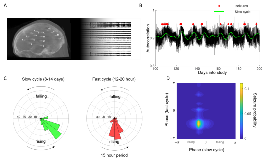Critical Slowing Down Governs the Onset of Epileptic Seizures
Abstract number :
1.075
Submission category :
2. Translational Research / 2A. Human Studies
Year :
2018
Submission ID :
499130
Source :
www.aesnet.org
Presentation date :
12/1/2018 6:00:00 PM
Published date :
Nov 5, 2018, 18:00 PM
Authors :
Matias Matuarna, University of Melbourne; Mark J. Cook, University of Melbourne, St Vincent's Hospital; Christian Meisel, University Clinic Carl Gustav Carus; and Dean R. Freestone, University of Melbourne, St Vincent's Hospital
Rationale: Over the recent years it has become clear that the abrupt state changes observed in many complex systems can be accurately described in the terminology of physics where they correspond to critical transitions. Critical transitions are typically preceded by critical slowing down; a system’s tendency to recover more slowly from small perturbations upon approaching the transition, which also manifests as an increase in variance and autocorrelation. The hypothesis that also the onset of epileptic seizures corresponds to a critical transition is interesting since critical slowing down might provide precise early-warning signals about an imminent seizure. Methods: Here we used long-term intracranial EEG recordings to thoroughly investigate critical slowing down in one patient. The patient underwent implantation of a 16-electrode system, each capturing continuous EEG signals at 400 Hz (Figure 1A). A total of 2.1 years of recording and 151 seizures was analysed. The autocorrelation and variance of the EEG was calculated from 1-second snapshots taken every 2-minutes. From this, we computed a wavelet transform to find prominent rhythms in the data that were related to seizures (figure 1B). Results: In this patient, we found strong daily and weekly rhythms. However, seizures were not necessarily linked to these rhythms. Instead, rhythms with a mean period of 16 hours and 11 days were strongly linked to seizures. Seizures occurred on a narrow rising phase of the autocorrelation signal (figure 1C), in line with critical slowing down. A similar relationship was observed with the signal variance. Warning signals were observed irrespective of electrode location. Using this information, we could generate a seizure probability map (Figure 1D), which can be used as a prior for a seizure forecasting algorithm. Conclusions: This is the first demonstration of critical slowing down prior to epileptic seizures using large scale human data. Most theoretical models that describe seizure dynamics suggest that critical slowing down should occur, but the temporal scale of the processes is unknown. Here we found that seizures are modulated by temporally long fluctuations in the autocorrelation and variance of the EEG. Two superimposed rhythms were observed, and seizures preferentially occurred on the rising phase of the combined signals. The seizure likelihoods determined from the autocorrelation and variance signals are useful priors, which could be combined with other measures to create a powerful seizure forecasting algorithm. The signals are easily detected, making them extremely useful as a biomarker for a clinical system. Funding: This research was supported by the National Health and Medical Research Council (APP1130468) and by the Melbourne Neuroscience Institute Fellowship.
